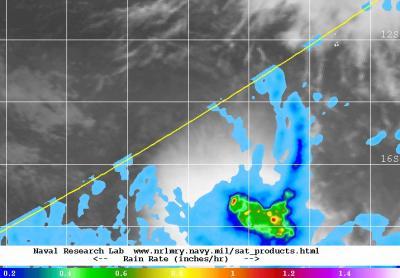Tropical Cyclone Jack may have hurricane-force winds today, April 21, but strong vertical wind shear is expected to weaken the storm. NASA's TRMM satellite passed overhead and saw that the bulk of the storm's rainfall was being pushed south of the center from the wind shear.
Tropical Cyclone Jack formed on Sunday, April 20, near 13.4 south and 91.1 east, and began moving to the south at 6 knots/6.9 mph/11.1 kph. Jack strengthened quickly and hours after its birth, the storm already had maximum sustained winds near 55 knots/63.2 mph/101.9 kph.
On April 21 at 0900 UTC/5 a.m. EDT, Tropical Cyclone Jack was moving through the Southern Indian Ocean at hurricane-force with maximum sustained winds near 75 knots/86.3 mph/138.9 kph. Jack was far from land and centered near 16.5 south latitude and 92.9 east longitude. That's about 346 nautical miles/398.0 miles/640.8 km southwest of Cocos Island. Jack was moving to the east-southeast at 10 knots/11.5 mph/18.5 kph.

NASA's TRMM satellite passed overhead on Apr. 21 and saw that the bulk of Tropical Cyclone Jack's rainfall was being pushed south of the center from the wind shear.
(Photo Credit: NRL/NASA/ESA)
The Joint Typhoon Warning Center noted that animated multispectral satellite imagery showed Jack continued in the buildup of thunderstorms despite strong vertical wind shear affecting them, and elongating the tropical cyclone to the southeast.
On April 21 at 04:02 UTC/12:02 a.m. EDT the microwave imager aboard NASA and the Japan Aerospace Exploration Agency's Tropical Rainfall Measuring Mission (TRMM) satellite was used to find an eye-like feature. By 12:15 UTC/8:15 a.m. EDT TRMM data no longer showed that eye-like feature. The Joint Typhoon Warning Center coupled TRMM data with infrared data from Europe's METEO-7 satellite to show Jack's clouds. That imagery showed how the rainfall was pushed to the south and southeast of the center by vertical wind shear.
Because of the increasing wind shear and the cooler sea surface temperatures in the direction Jack is moving, the storm is expected to weaken and dissipate in three days' time.
Source: NASA/Goddard Space Flight Center